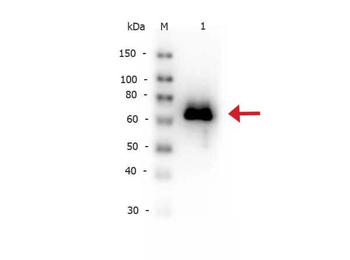You have no items in your shopping cart.
Biotin Glucose Oxidase Conjugated
Catalog Number: orb348745
| Catalog Number | orb348745 |
|---|---|
| Category | Tools |
| Description | Biotin Glucose Oxidase Conjugated |
| Conjugation | Biotin |
| Form/Appearance | Lyophilized |
| Concentration | 1.0 mg/mL |
| Buffer/Preservatives | 0.01 M Sodium Phosphate, 0.15 M Sodium Chloride, pH 7.2 |
| Purity | Biotin Glucose Oxidase Conjugated was prepared from chromatographically purified biotin. Biotin Glucose Oxidase Conjugated assayed by immunoelectrophoresis resulted in a single precipitin arc against anti-Glucose Oxidase and anti-Biotin. |
| Tested applications | DOT, ELISA, IHC, WB |
| Dilution range | ELISA: 1:8,000 - 1:32,000, IHC: 1:200 - 1:1,000, WB: 1:500 - 1:2,500 |
| Application notes | Biotin Glucose Oxidase Conjugated can be utilized in ELISA and Western Blotting experiments where the assay's target of interest is coupled with streptavidin. |
| Storage | Store vial at 4° C prior to restoration. For extended storage aliquot contents and freeze at -20° C or below. Avoid cycles of freezing and thawing. Centrifuge product if not completely clear after standing at room temperature. Biotin Glucose Oxidase Conjugated is stable for several weeks at 4° C as an undiluted liquid. Dilute only prior to immediate use. |
| Alternative names | Biotin Glucose Oxidase Conjugation, Glucose Oxidas Read more... |
| Hazard Information | Non-Toxic |
| Note | For research use only |

Dot Blot of BIOTIN GLUCOSE OXIDASE Conjugated. Lane 1: Biotin Conjugated Glucose Oxidase. Lane 2: Glucose Oxidase. Load: 3-fold serial dilution starting at 200 ng. Primary Antibody: None. Secondary antibody: HRP Streptavidin at 1:40000 for 30 min at RT. Block: 1% BSA-TTBS 30 min at RT.

Monitoring the interaction of a target with a specific ligand: (a) a microsensor's emitted-light intensity at 660 nm during the covalent binding of a 16.7 µm SAv solution with a microsensor's bare gold surface, followed by the interaction of a 1 nM bIgG solution with the microsensor-bound SAv. (◯) exponential-decay best-fits to the emitted-light intensities: R2(SAv) = 0.88, R2(bIgG) = 0.84. (b) a microsensor's emitted-light intensity at 660 nm during the covalent binding of a 2 µm SAv solution with the microsensor's bare gold surface, followed by the interaction of a 10 nM bGOx solution with the microsensor-bound SAv. (◯) exponential-decay best-fits to the emitted-light intensities: R2(SAv) = 0.99, R2(bGOx) = 0.96. (c) a microsensor's emitted-light intensity at 660 nm during the interactions of 100 mM DGlu/DPBS (50 mM βDGlu equivalent) and 100 mM LGlu/DPBS solutions with microsensor-bound bGOx. The specific microsensor was that shown in Figure 5(b). The LGlu solution had the same refractive index as the DGlu solution but did not bind to bGOx. Both DGlu/DPBS and LGlu/DPBS solutions produced fast emitted-light intensity changes on wash-in/wash out because they had a higher refractive index than DPBS. However, only the DGlu/DPBS solution produced a slower change in emitted-light intensity due to formation of βDGlu – bGOx complex. (d) a microsensor's emitted-light intensity at 660 nm during the covalent binding of a 2 µm SAv solution with the microsensor's bare-gold surface, followed by the interaction of a 66.7 nM bIgG solution with the microsensor-bound SAv. (◯) exponential-decay best-fits to the emitted-light intensities: R2(SAv) = 0.90, R2(bIgG) = 0.94. The sample flow rate in all experiments was ≈ 0.2 nL/s with a solution temperature of 24.0 ± 0.1 °C. * No signal was recorded during sample loading.
Rabbit Aspergillus niger Glucose oxidase, conjugated with Biotin Antibody [orb20848]
Aspergillus
Rabbit
Polyclonal
Biotin
1 mlPyranose Oxidase Antibody Biotin Conjugated [orb344318]
ELISA, IP, WB
Bacteria
Goat
Polyclonal
Biotin
100 μg
Biotin Glucose Oxidase Conjugated (orb348745)
Participating in our Biorbyt product reviews program enables you to support fellow scientists by sharing your firsthand experience with our products.
Login to Submit a Review





